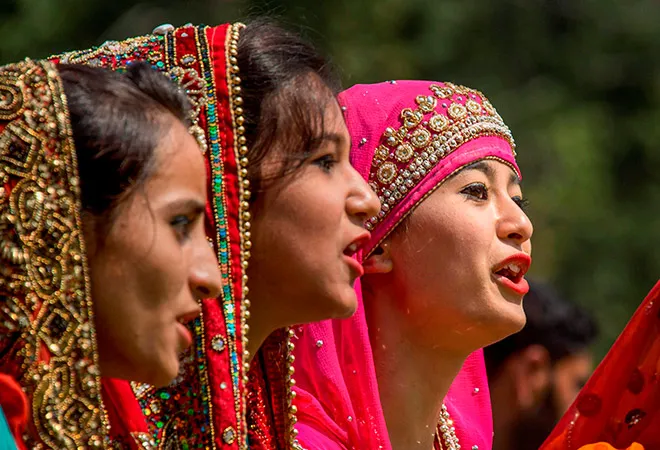-
CENTRES
Progammes & Centres
Location
A holistic approach to combat gender-based violence will never be complete without sincere efforts to trigger behaviour change among the perpetrators.

Image Source: Press Trust of India
Sustained IEC campaigns have shown remarkable successes in the past.
India ranked number one in the Thomson Reuters Foundation’s annual poll on the world’s most dangerous countries for women. Among the issues considered, India scored ‘one’ or ‘worst’ out of the top 10 in the category on sexual violence. It stood third out of the top 10 in the category on non-sexual violence. While the Ministry of Women and Child Development and the National Commission for Women along with several experts in India quite rightly rejected the results of this poll as being exaggerated and biased, one cannot deny the truth that gender-based violence (GBV) is indeed a huge problem in our country that needs to be addressed with a sense of urgency.
The National Family Health Survey (NFHS-4) conducted in 2015-16 mentions that 30 percent of women in India in the age group of 15-49 have experienced physical violence since age 15. Overall, the NFHS-4 reported six percent of women of the same age group to have experienced sexual violence at least once in their lifetime.
A large number of cases go unreported owing to the social stigma that is generally attached with such situations, especially when the victims have to register complaints against their own husbands, family members or other known persons.
Preventing GBV through mass ‘Information-Education-Communication’ (IEC) campaigns are worth considering for mitigating this scourge in India. These campaigns can supplement and complement the existing legal provisions such as the Protection of Women from Domestic Violence Act, 2005, the Sexual Harassment of Women at Workplace (Prevention, Prohibition and Redressal) Act, 2013, and Sections 354A, 354B, 354C and 354D of the Indian Penal Code — all dealing with issues of sexual harassment and other forms of abuse including voyeurism and stalking. However, these laws become effective only when women go ahead and register cases against their perpetrators, which seldom happens. Thus, a large number of cases go unreported owing to the social stigma that is generally attached with such situations, especially when the victims have to register complaints against their own husbands, family members or other known persons.
Therefore, these legal provisions instituted as deterrents to criminal activities generally end up becoming post-trauma measures. In 2013, as part of its ‘Making Mumbai Safe for Women and Children’ campaign, the Mumbai police partnered with ORF to launch an advertising campaign, where women were encouraged to come forward and register complaints on the Maharashtra Police’s ‘103’ helpline. The same year, O&M also created another campaign where the police warned men regarding the consequences that they could face on committing a gender-based crime. If promoted well across the nation, campaigns like these would actually help the law enforcement agencies seem as deterrents instead of a post trauma measure.
India still also lags in attempting to study, understand and change the psyche of the attackers. We still seem to largely ignore the view propagated by many experts that “in order to truly end violence and discrimination against women and girls, men and boys must be seen as more than part of the problem; they have to be seen as integral to the solution.” A holistic approach to combat GBV will never be complete without sincere efforts to trigger behaviour change among the perpetrators.
The story remains the same for all forms of gender-based violence — the society created them; therefore, the society needs to work towards reforming them.
Perpetrators of violence are not attuned to committing abuse at birth. They are mentally conditioned since their early years to behave that way. Madhumita Pandey interviewed 100 convicted rapists for her doctoral thesis at the criminology department, Anglia Ruskin University, UK. In an interview, she said, “When I went to research, I was convinced these men are monsters. But when you talk to them, you realise these are not extraordinary men, they are really ordinary. What they’ve done is because of upbringing and thought process.” The story remains the same for all forms of gender based violence — the society created them; therefore, the society needs to work towards reforming them.
Bringing about such reform will need, as a primary step, shifting the narrative from ‘men against women’ to making men part of the solution. Promoting a culture of healthy masculinities and getting rid of rigid stereotypes is essential. The CARE International Policy Brief, on ‘2016: The Year of Engaging Men and Boys in Stopping Gender-based Violence’ mentions how tackling masculinities directly is also about challenging the idea that violence against anyone — but especially violence based on gender or sexuality — is acceptable.
Young boys across the country are encouraged to show aggressive and dominant behaviour. The United Nations Population Fund (UNFPA) talks about how ideas regarding toxic masculinity are deeply ingrained into the minds of young boys from an early age. They are socialised into gender roles designed to keep men in power and in control and are also conditioned to believe that dominant behaviour towards girls and women is part of being a man. These stereotypes result in harming both women and men, and erode possibilities of establishing satisfying, mutually respectful relationships.
In order to change the situation, a lot of NGOs have started putting in serious efforts. “I don't really want to beat women, or harass them but we can't say it because then I am teased a lot,” said a young boy during a training workshop on gender equality organised by ‘Jagriti Youth’. Their discourse through these workshops revolve around breaking the generalisation of describing boys as wicked perpetrators and girls as victims.
Another innovative effort is the ‘Kishor Varta’ by the Centre for Health and Social Justice (CHSJ) who have developed a series of audio-visual stories around issues of body literacy, sexuality, gender discrimination, masculinity, menstruation, night ejaculation, girl’s mobility consent and age at marriage, etc. One can get connected with these audio stories through a basic mobile phone by dialing a toll free number.
Stereotypes result in harming both women and men, and erode the possibilities of establishing satisfying, mutually respectful relationships.
Though impactful, these efforts remain scattered in limited cities are not enough to combat the magnitude of the problem at hand. The Central Government on its part instituted the Nirbhaya Fund in the year 2013, for projects related to women’s safety. The corpus of this fund between 2013 and 2017 has grown to Rs 3,100 crore. Under this fund, 22 proposals on women’s safety and security from Central Ministries and State Governments amounting to Rs 2,209.19 crore have been appraised and recommended by the Empowered Committee. These 22 proposals include schemes such as ‘One-stop Centres’ that have been set up to facilitate access to an integrated range of services including medical, legal, and psychological support to women affected by violence. They will be integrated with ‘181’ and other existing helplines. So far, 151 One-stop Centres have become operational. The scheme of ‘Universalisation of Women Helpline’ is intended to provide 24 hours immediate and emergency response to women affected by violence through referral. This helpline will also provide information about women-related government schemes across the country.
While these schemes are implemented and eventually start showing results, they will not be able to solve the problem unless we initiate a sustained pattern to encourage behaviour change. This can be done by a collective Centre and State effort by championing a nationwide IEC campaign to encourage healthy masculinities. Sustained IEC campaigns have shown remarkable successes in the past. For example, the ‘do boond zindagi ki’ television commercial created for polio immunisation programme by UNICEF and the Ministry of Health and Family welfare in 2002. The commercial had movie star Amitabh Bachchan scolding mothers for not taking their children to polio booths. This, as well as concerted drives by local self-government bodies across India eventually led to a ‘polio-mukt Bharat’ (polio-free India) in the year 2014.
Another example of a social IEC campaign is the Swachh Bharat Mission (SBM), Prime Minister Narendra Modi’s flagship initiative aimed to achieve a diverse range of goals at the urban and rural level to clean up India and overcome open defecation by October 2019. Besides a range of television commercials that feature celebrities targeting different aspects of the campaign, SBM is also promoted through social media, radio spots, print ads and out-of-home advertising, and large-scale pan-India events.
In order to promote behaviour change at the grass root level through IEC a campaign like Hindustan Unilever’s ‘Roti reminder’ can be put into practice. During the Kumbh Mela (2013) they partnered with more than 100 dhabas and hotels at the mela site to serve over 2.5 million rotis that were stamped with “Lifebuoy se haath dhoye kya?” (Have you washed your hand with Lifebuoy?). Through this activity they encouraged the practice of washing hands before a meal helping combat diarrhoea and other related health issues.
Similarly, to spread awareness about GBV, Vogue India came up with the ‘ladke rulate nahi’ (boys don’t make anyone cry) campaign, while the ‘bell bajao’ (ring the bell) campaign against domestic violence released by ‘Breakthrough,’ a global human rights organisation, are both brilliant endeavours by private entities that address gender-based violence. Similar nationwide campaigns that receive a push on par with the cited government schemes implemented through a collective effort of the Centre, State and local self-government bodies will encourage behavior change in men and boys. If we want a truly ‘GBV mukt Bharat,’ it is high time we started talking about it collectively as a nation. A good way to begin would be to start nationwide, sustained and hi-impact IEC campaigns.
The views expressed above belong to the author(s). ORF research and analyses now available on Telegram! Click here to access our curated content — blogs, longforms and interviews.

Ami Pandya was Associate Fellow and New Media Manager at Observer Research Foundation Mumbai. She worked with the communication and outreach team in making research ...
Read More +